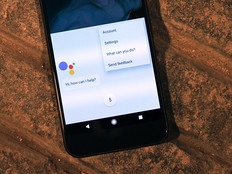How Can AI Improve Collaboration Technology?
What if your collaboration tools could actually understand the context of your words and deliver you what you really want, and not just web search results? What if it was like having another person in your office and not just a computer?
Cisco Systems is aiming to answer that, in part through a $125 million acquisition of AI company MindMeld, which it announced last month. Cisco wants to incorporate MindMeld’s AI platform into its collaboration products, because the tech allows users to build intelligent and human-like conversational interfaces for any application or device.
AI-enhanced collaboration tools have the potential to increase efficiency, speed up the discovery of new ideas and lead to improved outcomes for teams that are working together in disparate locations.
MindMeld’s proprietary machine learning (ML) technology improves the accuracy of voice and chat assistants and allows users to interact with them in more natural ways. The MindMeld application programming interface is currently being used by more than 1,200 companies globally, VentureBeat reports, and its customers and investors include Google, Samsung, Intel, Telefonica, Liberty Global, IDG, USAA, Uniqlo, Spotify and In-Q-Tel, a CIA investment fund.
“Creating a high-quality conversational interface requires six distinct types of ML, including Natural Language Processing, Question Answering, Dialog Management and so on,” Rowan Trollope, senior vice president of IoT and Applications at Cisco, said in a company blog post. “MindMeld has written the book on these technologies and has built the world’s best conversational user interface platform.”
Cisco Gets Serious About Incorporating AI Into Collaboration
Cisco has been aiming to bring AI to its collaboration tools for some time. Last June, Cisco partnered with IBM to integrate the Watson AI with its enterprise collaboration solutions. In July 2016, Cisco previewed Monica, a digital assistant for its Spark collaboration platform. Monica, trained with directory and scheduling information via machine learning, is designed to assist, participate, take action and more, Cisco says.
MindMeld's AI technology will “power new conversational interfaces” for Cisco's collaboration products, increasing ease of use and enabling new cognitive capabilities, the vendor says.
For example, users will be able to interact with Cisco Spark via natural language commands, allowing them to have an experience that is customized to their field of work. The larger goal is to bring that technology to conference rooms and to voice and videoconferencing technology everywhere.
Jens Meggers, Cisco’s senior vice president and general manager for the Cloud Collaboration Technology Group, told the website No Jitter that Cisco sees AI as a necessary component of collaboration tools going forward. “We will see, in the next two to five years, collaboration products becoming more intelligent,” he said. “It's an unstoppable trend.”
IT industry analyst Zeus Kerravala, writing on No Jitter, says there are many easy ways for Cisco to integrate MindMeld with its Spark platform:
- Spark Bot — A chat assistant that would interact with workers and execute tasks autonomously
- Spark Care Bot — A virtual agent that would handle customer care instead of a human
- Spark Board — Contextual voice or video interactions to enable more efficient meetings
- Spark Room Kit — Enhance smaller meetings through audio and video
How AI Can Enhance Collaboration Tools
How could technologies like MindMeld and others that use natural language processing work? Kerravala notes that, since MindMeld is a cloud-based solution, it is able to aggregate information from its customers, making it more accurate and intelligent.
“MindMeld gives businesses the ability to own and control the data and models while providing a base of data that gets them around a ‘cold start’ period during which the AI needs to go through a learning phase before it can become useful,” he says. “Since MindMeld already has done that heavy-lifting, inference accuracy should be high.”
To further illustrate the potential of this enhancement, Kerravala says that once Cisco integrates MindMeld’s tech into its products, “a group of doctors in a room outfitted with a Spark Board could ask the device to pull up a patient's health records and X-rays. Or a project team could ask Spark Board to find the most relevant information on oil and gas exploration, and the MindMeld ML algorithms would quickly do so.”
In the company blog, Trollope says that Cisco has realized that for users to have “more natural, conversational interactions in our enterprise collaboration tools, we’d have to do more for them, and do more of the heavy lifting.”
According to Kerravala, as the amount of data in the workplace continues to grow exponentially, “an AI capability accessed through speech and messages must drive the future of work.”









